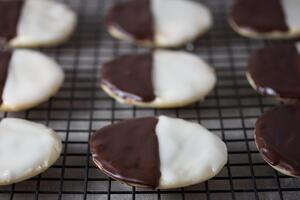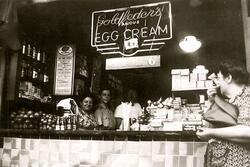Black and White: The Perfect Cookie
Here’s a perfectly innocuous secret: I really don’t mind prepackaged black and whites.
When you don’t live in New York, the prepackaged kind is a treat: brought back from Zabar’s after a work conference, grabbed last minute at LaGuardia before boarding a flight, or shipped down the East Coast in a holiday basket. I like the consistency of what I’m getting—the snap of hardened vanilla fondant between my teeth, the slight smear of chocolate left behind on the wrapper.
All of this is to say that while I usually enjoy attempting my favorite baked goods at home, I’ve never made black and whites from scratch. I have enjoyed the mystery of how the white icing and spread of chocolate meet so neatly in the middle, how the bottom is usually spongy and soft. Sure, there are variations between delicatessens’ cookies—but in general, I know exactly what I’m getting when I impulsively grab a bundle of them at the cash register.
My not-particularly-principled stand against knowing the secrets of my faithful post-Reuben cookies ended this week, as a dear friend of mine visited me en route to start a new position in Brooklyn. Sending her off to New York felt like the perfect occasion to finally see if black and whites could be approximated in my home kitchen. We’d met as undergraduates in a Jewish Studies course to begin with, so it didn’t take much to convince her these would be worth our time and effort.
It occured to me as my excitement began to build that I wasn’t actually sure why black and white cookies are a staple of Jewish delicatessen. Tablet Magazine’s 100 Jewish Foods feature on black and whites admits the origins are a little hazy. They were certainly brought over to the United States by some Eastern European population, and their popularity was solidified almost immediately in New York’s food scene at the turn of the century. They are ubiquitous and well-loved—a part of American Jewish foodways by virtue of so many generations of Jews making, selling, and buying them.
In preparation for the evening’s attempt, I spent precisely eleven minutes scanning the first page of results that popped up when I searched “black and white cookies how to make?” on Google.
I chose The Nosher’s promisingly-named article “The Secret to the Best Black and White Cookie.” Amanda Balagur evaluated three recipes in her article: one from Zabar’s, one from The Nosher’s own archives, and one that made a splash in the New York Times Cooking section earlier this summer. The New York Times recipe included a delightful video with food editor Melissa Clark, documenting taste-tests across many iconic NYC delis and bakeries as she gathered intel for her own baking attempt. According to Balagur, the Clark recipe was based on the black and whites made at William Greenberg Desserts in Manhattan, which I have not been fortunate enough to visit but do remember seeing reference to on Mad Men. My task, as I saw it, was not to reinvent the wheel of at-home black and white cookie testing—Balagur and many other home bakers have written much on the subject—but rather to see if I could make it happen for myself on a graduate student stipend.
Each week, I spend hours watching The Great British Bake Off and scrolling through enviable baking Instagram accounts, but far less time actually turning on the oven and making cookies or cakes from scratch. This mostly comes down to cost: It’s not economically practical for me to purchase almond extract I’ll use maybe once in a six-month period when I’m living on a shoestring budget. I usually have the basics on hand, but anything beyond flour, eggs, and sugar can feel like a lavish expense. Visiting my parents is a thrilling excuse to make use of their array of spices, flours, and pots and pans. My fantasies now mainly revolve around owning a stand mixer.
When attempting the black and whites, mixing proved to be our first stumble. Clark’s recipe for the Times does not endorse hand-mixing, but with no Kitchenaid in sight, Mackenzie and I took turns attempting to soften the butter down into our liquid mixture, lump free. I was sweaty almost immediately. The first hidden step in the recipe (for anyone lacking electronic help) is going to the gym.
Once the mixture resembled, as Clark describes it, “thick pound cake batter,” Mackenzie and I began trying to mold it into dollops on a prepared baking sheet. Though the recipe noted the precise amount needed to form a cookie (1/4th of a cup), it also suggested using an ice cream scoop for consistency in shape. Did I have an ice cream scoop? Absolutely not. We soldiered on, making a veritable mess as we scooped the mixture directly into our measuring cup, scraped the top even with knives, and then attempted to scoop that mixture out and onto the pan. This left us with the frustrating task of shaping the would-be cookies back into a round, recognizable blob. I worried that the uneven shapes would lead to imprecise baking, and also take us farther from the classic look of the cookies. But we had come this far.
Our goal post had moved from copycat to general gist, and with that in mind, we dutifully put our lumps into the oven and rotated them as the recipe suggested. Clark writes that you ought to test the cookies by pressing lightly into their center, and seeing if they spring back. This, for our oven and batter thickness, took a little longer than her suggested 6-9 minutes. I was terrified of overbaking, and so Mackenzie and I sat directly in front of the oven like we were contestants on Bake-Off. When we finally felt satisfied that the cookies were more or less in their final form, we transferred them to a wire rack and got to work on the black and white part of making black and white cookies.
Reader, I am happy to report that the Clark recipe for vanilla and chocolate is perfect, as far as my tastes and memory are concerned. Most importantly—the leftover vanilla frosting becomes the chocolate glaze, thanks to the magic of unsweetened chocolate. This is an important note—though the Clark recipe calls for just 2 oz of unsweetened chocolate to be added to the vanilla frosting mixture, along with cocoa powder, I decided to forgo the powder and just use the melted chocolate, compensating for the lost cocoa with a few extra ounces of melted bar. This was undoubtedly the right choice, if you’re a sugar fanatic like myself.
Decorating was the final hurdle. We didn’t have any fancy edging tools, but starting with the vanilla, we scraped the topping onto the cookies with a spoon and then let those dry. Then we transformed the vanilla fondant into a chocolate glaze and covered the remaining plain halves. The glaze was incredibly difficult to spread (undoubtedly because I added more melted chocolate than suggested), but truly decadent. We could hardly wait for them to cool to taste-test.
The final verdict? Taste-wise: Perfection. Texture-wise? A little lacking—but I am certain that access to a stand mixer and an ice cream scoop would have made the final result look a lot closer to Clark’s. Within these parameters, we were astounded at our own baking prowess. I plan to make these again when I’m with my parents, and their Kitchenaid mixer, in just a few weeks and I have a feeling these will become part of my (semi-regular) rotation.
Because the black and white isn’t actually connected to any Jewish holiday or tradition, they’re perfect year-round. Thanksgiving? Black and whites. Hanukkah? Black and whites. Passover? Not kosher, but you get the point.







